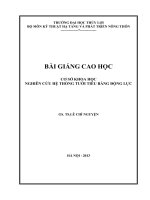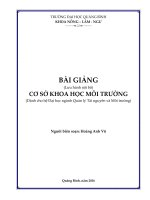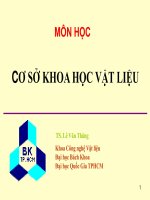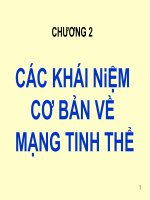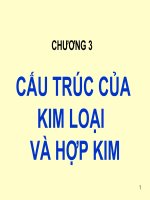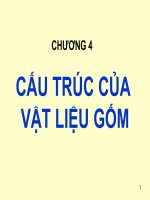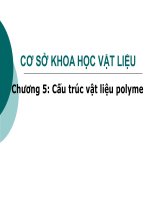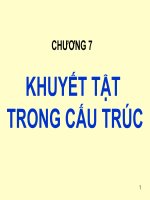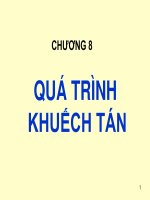Bài giảng Cơ sở khoa học của biến đổi khí hậu (Đại cương về BĐKH) – Phần II: Bài 7 – ĐH KHTN Hà Nội
Bạn đang xem bản rút gọn của tài liệu. Xem và tải ngay bản đầy đủ của tài liệu tại đây (2.48 MB, 15 trang )
VNU HANOI UNIVERSITY OF SCIENCE
REGIONAL CLIMATE MODELING AND CLIMATE CHANGE
CƠ SỞ KHOA HỌC
CỦA BIẾN ĐỔI KHÍ HẬU
(Đại cương về BĐKH)
Phần II
----------------------------------------------------------Phan Van Tan
B07: Tác động bức xạ và BĐKH
Bài 1: Các thành phần của hệ thống khí hậu
Bài 2: Sự truyền bức xạ và khí hậu
Bài 3: Hồn lưu khí quyển và khí hậu
Bài 4: Bề mặt đất, Đại dương và khí hậu
Bài 5: Lịch sử và sự tiến triển của khí hậu Trái đất
Bài 6: Khái niệm về Biến đổi khí hậu
Bài 7: Tác động bức xạ và BĐKH
Bài 8: Biến đổi trong các thành phần của hệ thống khí hậu
Bài 9: Biến đổi của các hiện tượng cực đoan
Bài 10: Giới thiệu về khí hậu Việt Nam
Bài 11: Biến đổi khí hậu ở Việt Nam
Bài 12: Mơ hình hóa khí hậu
Bài 13: Dự tính khí hậu
Bài 14: Xây dựng kịch bản BĐKH
Bài 15: Tác động của BĐKH và tính dễ bị tổn thương do BĐKH
Khái niệm tác động bức xạ
| Tác động bức xạ: Radiative Forcing (RF)
| IPCC AR5, Chap. 8:
{ “Alternative definitions of RF have been developed, each with
its own advantages and limitations. The instantaneous RF
refers to an instantaneous change in net (down minus up)
radiative flux (shortwave plus longwave; in Wm–2) due to an
imposed change. This forcing is usually defined in terms of
flux changes at the top of the atmosphere (TOA) or at the
climatological tropopause, with the latter being a better
indicator of the global mean surface temperature response in
cases when they differ”
Tác động bức xạ
| RF là thước đo ảnh hưởng của một nhân tố trong việc làm
thay đổi cân bằng năng lượng đến và đi của hệ thống Trái đất
– khí quyển
| RF được xác định so với điều kiện khí hậu thời kỳ tiền cơng
nghiệp 1750
| Trong bối cảnh BĐKH, khái niệm “tác động” (forcing) được
hạn chế đối với những biến đổi trong cân bằng bức xạ của hệ
thống bề mặt – tầng đối lưu gây nên bởi các nhân tố bên
ngồi
{ khơng có biến đổi trong động lực tầng bình lưu,
{ khơng có hồi tiếp từ bề mặt và tầng đối lưu (tức là khơng có ảnh
hưởng gián tiếp do sự biến đổi trong chuyển động ở tầng đối lưu
hoặc trạng thái nhiệt động của nó),
{ và về động lực học khơng có những biến đổi về lượng và sự phân bố
nước trong khí quyển (các trạng thái hơi, lỏng và rắn của nước).
Tác động bức xạ
| Định lượng tác động bức xạ (RF) là thước đo trực tiếp tốc độ đốt
nóng trung bình do sự hiện diện của một lượng KNK cho trước
trong khí quyển
| Tuy nhiên, tiềm năng của một chất khí làm gia tăng hiệu ứng nhà
kính trong tương lai phụ thuộc vào sự biến đổi hàm lượng của chất
khí đó
Đỉnh tầng đối lưu
RF=0
Đỉnh tầng đối lưu
RF>0
Đỉnh tầng đối lưu
RF<0
Cân bằng năng lượng bức xạ tồn cầu
Điều gì xảy ra
nếu hàm lượng
các chất khí nhà
kính tăng lên?
Tiềm năng nóng lên tồn cầu
| Tiềm năng nóng lên tồn cầu (global warming
potential - GWP) là lượng được tính đến gồm 4 yếu tố:
{ RF đối với một lượng chất khí đã biết (W m-2);
{ Nguồn phát thải của chất khí;
{ Tuổi thọ của chất khí trong khí quyển (đo bằng số năm);
{ Hiệu ứng gián tiếp của chất khí đến RF
| GWP là RF dự báo (dự tính) của một chất khí trong một
khoảng thời gian cho trước, chẳng hạn 20, 100 hay 500 năm
tính từ thời điểm hiện tại
| Như vậy, với một chất khí cho trước có các thuộc tính bức xạ
nào đó, nguồn phát thải nào đó và tuổi thọ nào đó trong khí
quyển thì RF sẽ là bao nhiêu trong 20, 100 hay 500 năm tới?
| Đây là con số cơ bản để dự báo RF trong tương lai
Tiềm năng nóng lên tồn cầu
Species
Chemical
formula
Lifetime
(yr)
Global Warming
Potential
20 yr 100 yr
500 yr
Carbon dioxide
CO2
Variable
1
1
1
Methane *
CH4
12±3
56
21
6.5
Nitrous oxide
N2O
120
280
310
170
HFC-23
CHF3
264
9100 11700 9800
HFC-32
CH2F2
5.6
2100
HFC-43-10mee
C5H2F10
HFC-125
Perfluoropentane
650
200
17.1
3000 1300
400
C2HF5
32.6
4600 2800
920
C5F12
4100
5100 7500 11000
Ảnh hưởng của tác động bức xạ
| Effective Radiative Forcing (ERF) is the change in net
TOA downward radiative flux after allowing for
atmospheric temperatures, water vapour and clouds to
adjust, but with surface temperature or a portion of
surface conditions unchanged
a known large uncertainty in the radiative transfer calculations (see
further description in Section 8.3.1).
compared to AR4, as the evidence is improved and is now medium (see
Section 7.5.2).
Figure 8.14 shows the development of the confidence level over the
last four IPCC assessments for the various RF mechanisms. In the previous IPCC reports level of scientific understanding (LOSU) has been
Table 8.6 shows the best estimate of the RF and ERF (for AR5 only)
for the various RF agents from the various IPCC assessments. The RF
due to WMGHG has increased by 16% and 8% since TAR and AR4,
Hiểu biết của con người về RF
Figure 8.14 | Confidence level of the forcing mechanisms in the 4 last IPCC assessments. In the previous IPCC assessments the level of scientific understanding (LOSU) has been
adopted instead of confidence level, but for comparison with previous IPCC assessments the LOSU is converted approximately to confidence level. The thickness of the bars represents the relative magnitude of the current forcing (with a minimum value for clarity of presentation). LOSU for the RF mechanisms was not available in the first IPCC Assessment
Anthropogenic and Natural Radiative Forcing
RF và ERF
Chapter 8
Radiative forcing of climate between 1750 and 2011
Forcing agent
CO2
Anthropogenic
Well Mixed
Greenhouse Gases
Other WMGHG
Ozone
CH4 N2O
Stratospheric
Halocarbons
Tropospheric
Stratospheric water
vapour from CH4
Surface Albedo
Black carbon
on snow
Land Use
Contrails
Contrail induced cirrus
Aerosol-Radiation Interac.
Natural
Aerosol-Cloud Interac.
Total anthropogenic
Solar irradiance
-1
0
1
Radiative Forcing (W m-2)
2
3
Figure 8.15 | Bar chart for RF (hatched) and ERF (solid) for the period 1750–2011, where the total ERF is derived from Figure 8.16. Uncertainties (5 to 95% confidence range)
Figure 8.15 | Bar chart for RF (hatched) and ERF (solid) for the period 1750–2011, where th
are given for RF (dotted lines) and ERF (solid lines).
Hàm mật độ xác suất của ERF
AR4 RF
Probability density function
1.2
Greenhouse
gases
1.0
0.8
Aerosols
Total
anthropogenic
0.6
0.4
0.2
0.0
-2
0
2
Effective radiative forcing (Wm-2)
4
The
cau
an
ab
an
Thi
thu
aer
of
Fig
po
act
by
8.1
)
Figure 8.17 | RF bar chart for the period 1750–2011 based on emitted compounds
(
the other hand, have indirect effects that lead to positive RF through
ozone production and also effects that lead to negative RF through
Emis
tions
The e
parti
net R
is clo
RF fr
inter
and
of SO
the v
has n
For t
uncer
ERF o
to 2.
osph
The ti
the I
and
er pe
an al
ERF.
eral i
WM
of C
genic
(aero
8.5.
RF
he
ral
to
or
his
he
he
as
ry
or
te
he
is
te
me
he
nd
he
anthropogenic RF. The forcing due to aerosols is rather weak leading
RF trend
(
)
Chapter 8
RF (hatched) and ERF (solid) for the period 1980–2011
Radiative forcing of climate between 1980 and 2011
Forcing agent
Well Mixed
Greenhouse Gases
CO2
Other WMGHG
N2O
CH4
Halocarbons
Anthropogenic
8
Ozone
Stratospheric
Tropospheric
Stratospheric water
vapour from CH4
Surface Albedo
Contrails
BC on snow
+ Land Use
Contrail induced cirrus
Aero.-Rad. Interac.
Aero.-Cloud Interac.
Natural
Total anthropogenic
Solar irradiance
-0.5
0.0
0.5
1.0
-2
Radiative Forcing (W m )
A
of atmospheric chemistr
cussion on the represen
with the broader set of
tion 11.3.5 and Section
project provided projec
hereafter highlight thos
contributions of various
forcing is useful, we em
all aerosol–radiation a
most indicative of the a
present traditional RF d
called direct aerosol ef
components of aerosol
uncertainty ranges, are d
are also CMIP5 models
(relative to 2000), and h
tion to persistent forcing
Analysis of forcing at 20
total ozone (tropospher
due to aerosol–radiatio
WMGHG forcing domina
WMGHG forcing is dom
increasing N2O have ne
Aerosol ERF was not ev
